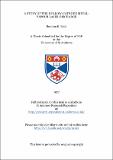Files in this item
A study of the hollow-cathode metal-vapour laser discharge
Item metadata
| dc.contributor.advisor | Maitland, Arthur | |
| dc.contributor.advisor | Dunn, Malcolm H. | |
| dc.contributor.author | Belal, Ibrahim K. | |
| dc.coverage.spatial | 179 p. | en_US |
| dc.date.accessioned | 2018-06-18T09:21:09Z | |
| dc.date.available | 2018-06-18T09:21:09Z | |
| dc.date.issued | 1977-07 | |
| dc.identifier.uri | https://hdl.handle.net/10023/14162 | |
| dc.description.abstract | This work is a plasma diagnostic study of the hollow; cathode metal vapour laser. It can be divided into three sections. Section one concerns the study of the basic parameters (cathode fall potential electric field, cathode fall width; negative glow length and gas temperature) of the hollow cathode discharge. Section two concerns the use of absorption, linewidth and laser lieterodyne techniques to measure the number densities of He- (21S), (23S) states and He+ ions (electrons) since these species are involved in the pumping mechanisms (Penning and Duffendack) leading to population inversions. Section three concerns the emission, radial profiles of the excited states of He I and He II so the influence of the high energy electrons which enter the negative glow from, the cathode fall region can be studied as they cross the glow. Although the metastable number densities in the hollow cathode are comparable to those in the positive column, they behave differently. In the positive column both singlet and triplet metastables saturate with respect to the discharge current. In the hollow cathode the singlets saturate not only with respect to discharge current but also with respect to pressure. On the other hand the triplets increase linearly with the discharge current and follows' the cathode fall potential as a function of pressure. In the positive column the saturation of the metastable number densities with current combined with the cadmium ion drive-out to the walls lead to the laser power output limitation. In the hollow cathodo cadmium ion drive-out still occurs however this can be compensated by increasing the metal atom, number density since in this case the cathode fall potential, and hence electron energy, is not thereby decreased. Stark broadening and laser heterodyning were used to measure the ion number density and both techniques agree well. They show that the ion number density increases linearly with current, and follows the cathode fall potential as a function of pressure. Also they show that the electron (ion) number density in a hollow cathode is about two orders of magnitude larger than that in a positive column which may lead to an enhancement in the Duffendack reaction. The excitation radial profiles show that the negative glow receives a flux of electrons with energy derived directly from the cathode fall potential. These electrons play an important par in the collision processes in the negative glow. The correlation between these regions is shown clearly by studying the rate equations for different species. The behaviour of the species number densities in the negative glow with the discharge parameters can be related to the fundamental process occuring in the dark space. | en_US |
| dc.language.iso | en | en_US |
| dc.publisher | University of St Andrews | |
| dc.subject.lcc | TK7872.L3B3 | |
| dc.subject.lcsh | Lasers | |
| dc.title | A study of the hollow-cathode metal-vapour laser discharge | en_US |
| dc.type | Thesis | en_US |
| dc.contributor.sponsor | SERC | en_US |
| dc.type.qualificationlevel | Doctoral | en_US |
| dc.type.qualificationname | PhD Doctor of Philosophy | en_US |
| dc.publisher.institution | The University of St Andrews | en_US |
This item appears in the following Collection(s)
Items in the St Andrews Research Repository are protected by copyright, with all rights reserved, unless otherwise indicated.

